Construction/Drawing of the Support and Resistance level
Here is a 4 step guide to help you understand how to identify and construct the support and the resistance line.
Step 1) Load data points – If the objective is to identify short term S&R load at least 3-6 months of data points. If you want to identify long term S&R, load at least 12 – 18 months of data points. When you load many data points, the chart looks compressed. This also explains why the above two charts looks squeezed.
- Long term S&R – is useful for swing trading
- Short term S&R – is useful intraday and BTST trades
Here is a chart where I have loaded 12 months of data points
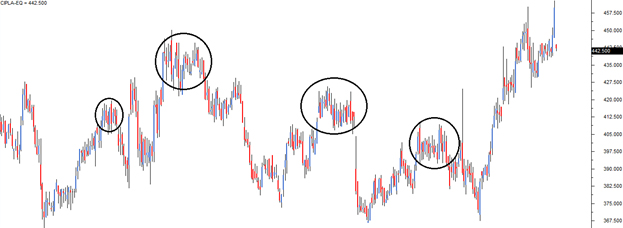
Step 2) Identify at least 3 price action zones – A price action zone can be described as ‘sticky points’ on chart where the price has displayed at least one of the behaviors:
- Hesitated to move up further after a brief up move
- Hesitated to move down further after a brief down move
- Sharp reversals at particular price point
Here are a series of charts that identifies the above 3 points in the same order:
In the chart below, the encircled points indicate the price hesitating to move up further after a brief up move:
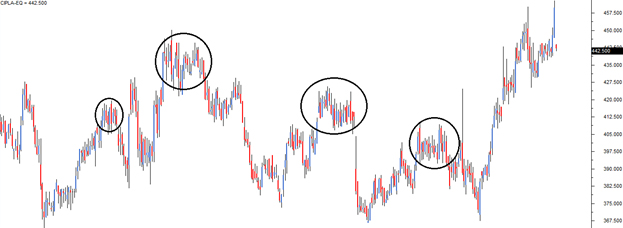
In the chart below, the encircled points indicate the price hesitating to move down further after a brief down move:
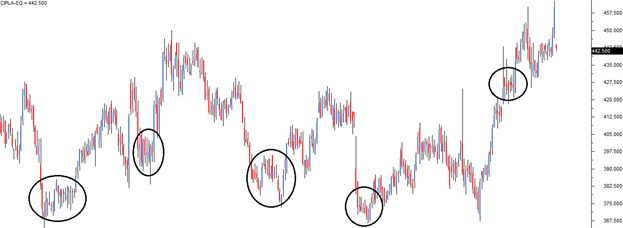
In the chart below, the encircled points indicate sharp price reversals:
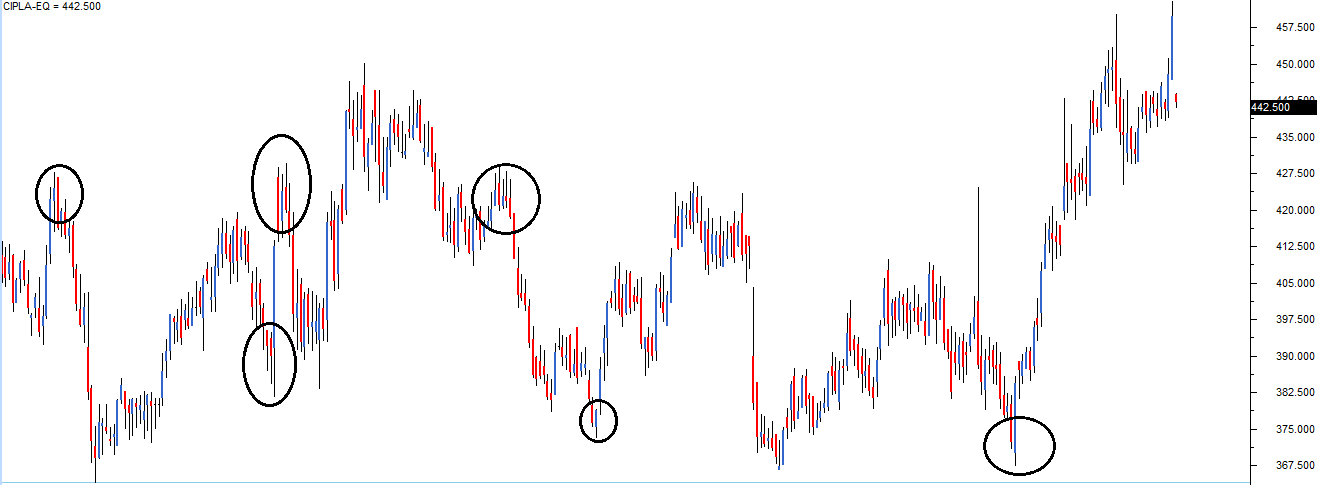
Step 3) Align the price action zones – When you look at a 12 month chart, it is common to spot many price action zones. But the trick is to identify at least 3 price action zones that are at the same price level.
For example here is a chart where two price action zones are identified but they are not at the same price point.
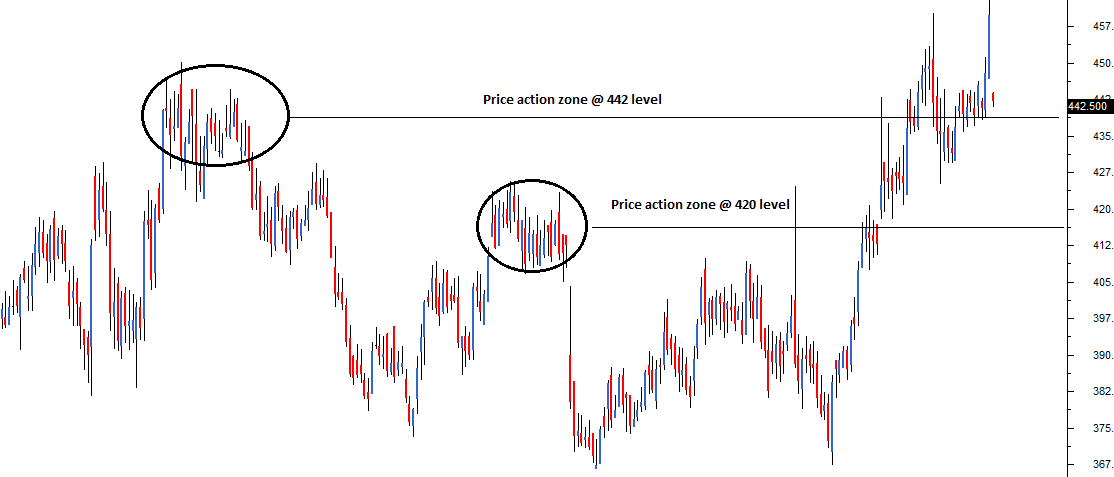
Look at the following chart, I have encircled 3 price action zones that are around the same price points:
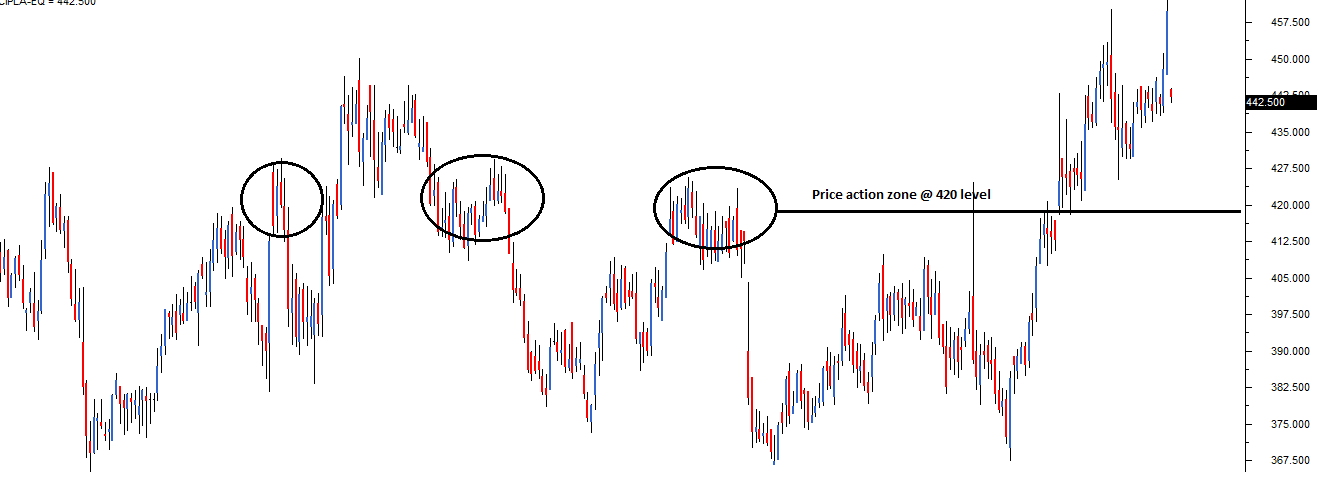
A very important point to note while identifying these price action zones is to make sure these price zone are well spaced in time. Meaning, if the 1st price action zone is identified on 2nd week on May, then it will be meaningful to identify the 2nd price action zone at any point after 4th week of May (well spaced in time). The more distance between two price action zones, the more powerful is the S&R identification.
Step 4) Fit a horizontal line – Connect the three price action zones with a horizontal line. Based on where this line fits in with respect to the current market price, it either becomes a support or resistance.
Have a look at this chart
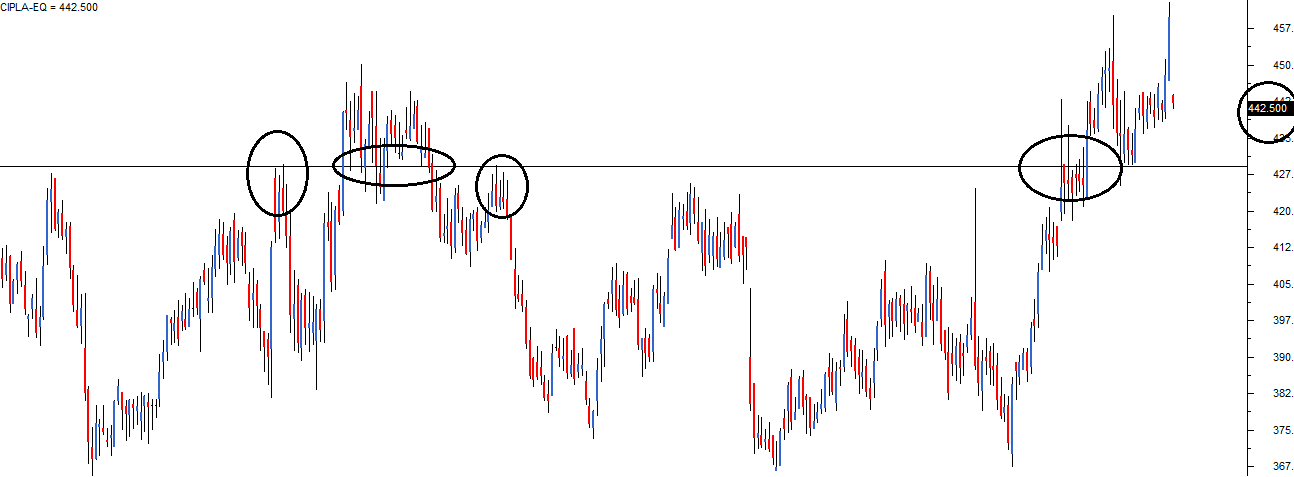
Starting from left:
- The 1st circle highlights a price action zone where there is a sharp reversal of price
- The 2nd circle highlights a price action zone where price is sticky
- The 3rd circle highlights a price action zone where there is a sharp reversal of price
- The 4th circle highlights a price action zone where price is sticky
- The 5th circle highlights the current market price of Cipla – 442.5
In the above chart all the 4 price action zones are around the same price points i.e at 429. Clearly, the horizontal line is below the current market price of 442.5, thus making 429 as an immediate support price for Cipla.
Please note, whenever you run a visual exercise in Technical Analysis such as identifying S&R, you run the risk of approximation. Hence always give room for error. The price level is usually depicted in a range and not at a single price point. It is actually a zone or an area that acts as support or resistance.
So going by the above logic, I would be happy to consider a price range around 426 to 432 as a support region for Cipla. There is no specific rule for this range, I just subtracted and added 3 points to 429 to get my price range for support!
Here is another chart, where both S&R have been identified for Ambuja Cements Limited.
The current price of Ambuja is 204.1, the support is identified at 201 (below current market price), and the resistance at 214 (above current market price). So if one were to short Ambuja at 204, the target, based on support can be at 201. Probably this would be a good intraday trade. For a trader going long at 204, 214 can be a reasonable target expectation based on resistance.
Notice in both the support and the resistance level, there at least 3 price action zone identified at the price level, all of which are well spaced in time.
Reliability of S&R
The support and resistance lines are only indicative of a possible reversal of prices. They by no means should be taken for as certain. Like anything else in technical analysis, one should weigh the possibility of an event occurring (based on patterns) in terms of probability.
For example, based on the chart of Ambuja Cements –
Current Market Price = 204
Resistance = 214
Resistance = 214
The expectation here is that if at all Ambuja cements starts to move up it is likely to face a resistance at 214. Meaning, at 214 sellers could emerge who can potentially drag the prices lower. What is the guarantee that the sellers would come in at 214? In other words, what is dependence of the resistance line? Honestly, your guess is as good as mine.
However, historically it can be seen that whenever Ambuja reached 214, it reacted in a peculiar way leading to the formation of a price action zone. The comforting factor here is that the price action zone is well spaced in time. This mean 214 stands as a time tested price action zone. Therefore keeping the very first rule of technical analysis in perspective i.e “History tends to repeat itself” we go with the belief that support and resistance levels will be reasonably honored.
Purely from my personal trading experience well constructed S&R points are usually well respected.
Optimization and checklist
Perhaps, we are now at the most important juncture in this module. We will start discovering few optimization techniques which will help us identify high quality trades. Remember, when you seek quality, quantity is always compromised, but this is a compromise that is worth making. The idea is to identify quality trading signals as opposed to identifying plenty, but worthless trades.
Optimization in general is a technique wherein you fine tune a process for best possible results. The process in this context is about identifying trades.
Let us go back to candlesticks patterns, maybe to the very first we learnt – bullish marubuzo. A bullish marubuzo suggests a long trade near the close of the marubuzo, with the low of the marubuzo acting as the stoploss.
Assume the following credentials for the bullish marubuzo:
Open = 432, High = 449, Low = 430, Close = 448
Hence the entry for the long trade is approximately at 448, with 430 as the stoploss.
Now what if the low of the marubuzo also coincides with a good time tested support? Do you see a remarkable confluence of two technical theories here?
We have a double confirmation to go long. Think about it on following terms:
- A recognized candlestick pattern (bullish marubuzo) suggests the trader to initiate a long trade
- A support near the stoploss price suggests the trader the presence of significant buying interest around the low
While dealing with a fairly random environment such as the markets, what a trader really needs is a well crafted trade setup. The occurrence of the above two conditions (marubuzo + support near the low) suggests the same action i.e to initiate a long trade in this case.
This leads us to an important idea. What if we had a checklist (call it a framework if you like) for every trade that we consider? The checklist would act as a guiding principle before initiating a trade. The trade should comply to the conditions specified in the checklist. If it does, we take the trade; else we just drop it and look for another trade opportunity that complies with the checklist.
Discipline, they say makes up for the 80% of the trader’s success. The checklist in my opinion forces you to be disciplined; it helps you avoid taking abrupt and reckless trading decision.
In fact to begin with we have the first two very important factors of the checklist:
- The stock should form a recognizable candlestick pattern
- Note: We have learnt some of the popular patterns in this module. To begin with you can use just these patterns to comply with checklist
- S&R should confirm to the trade. The stoploss price should be around S&R
- For a long trade, the low of the pattern should be around the support
- For a short trade, the high of the pattern should be around the resistance



No comments:
Post a Comment